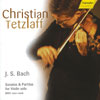Bach Sonatas & Partitas for Solo Violin, BWV1001-06
An imaginative player offers an outstanding reading of the violin's 'old testament'
View record and artist detailsRecord and Artist Details
Composer or Director: Johann Sebastian Bach
Genre:
Instrumental
Label: Hänssler
Magazine Review Date: 8/2007
Media Format: CD or Download
Media Runtime: 130
Mastering:
Stereo
DDD
Catalogue Number: CD98250

Tracks:
| Composition | Artist Credit |
|---|---|
| (3) Sonatas and 3 Partitas |
Johann Sebastian Bach, Composer
Christian Tetzlaff, Violin Johann Sebastian Bach, Composer |
Author: DuncanDruce
Christian Tetzlaff, always one of the most thoughtful, imaginative violinists, has obviously found Bach’s solo works a stimulating and rewarding challenge. Technically, he’s most impressive: using a modern bow, he can achieve, with each phrase, the kind of subtle give and take that’s normally the preserve of the best Baroque violinists. His chord playing, too, shows wonderful control; in the more densely polyphonic pieces – the Chaconne and the fugues in the three sonatas – it seems there’s often little choice between aggressive accentuation and rhythmic distortion caused by spreading the chords. Tetzlaff, however, manages to avoid both pitfalls, with varied arpeggiation that never fails to take account of the music’s rhythmic requirements.
The performances have a remarkable air of spontaneity, the result of a pervasive rubato especially notable in the ornamented opening movements of the first two sonatas, and in the freer sections of the Chaconne. There’s a sense of line and balance that ensures that each departure from metronomic regularity sounds entirely natural, unlocking the music’s expressive potential. I felt this even when, in a few movements in the partitas, the dance character suggests a more regular, metrical pulse. Apart from this, it’s notable how Tetzlaff realises the virtuosity of Bach’s violin writing – the moto perpetuo finales of the sonatas sound truly thrilling, full of temperament and fire. Even if you’ve fallen for Julia Fischer’s beautifully stylish, polished accounts, or the expressive richness of Richard Tognetti’s gut-strung Guadagnini, I’d urge you to investigate this outstanding set.
The performances have a remarkable air of spontaneity, the result of a pervasive rubato especially notable in the ornamented opening movements of the first two sonatas, and in the freer sections of the Chaconne. There’s a sense of line and balance that ensures that each departure from metronomic regularity sounds entirely natural, unlocking the music’s expressive potential. I felt this even when, in a few movements in the partitas, the dance character suggests a more regular, metrical pulse. Apart from this, it’s notable how Tetzlaff realises the virtuosity of Bach’s violin writing – the moto perpetuo finales of the sonatas sound truly thrilling, full of temperament and fire. Even if you’ve fallen for Julia Fischer’s beautifully stylish, polished accounts, or the expressive richness of Richard Tognetti’s gut-strung Guadagnini, I’d urge you to investigate this outstanding set.
Discover the world's largest classical music catalogue with Presto Music.

Gramophone Digital Club
- Digital Edition
- Digital Archive
- Reviews Database
- Full website access
From £8.75 / month
Subscribe
Gramophone Full Club
- Print Edition
- Digital Edition
- Digital Archive
- Reviews Database
- Full website access
From £11.00 / month
Subscribe
If you are a library, university or other organisation that would be interested in an institutional subscription to Gramophone please click here for further information.




